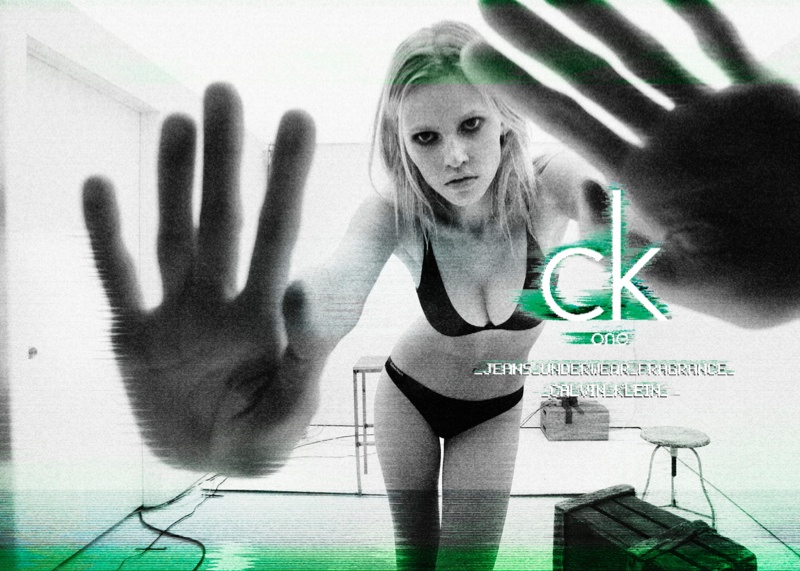Post an example of a photographic advertisement and write a corresponding essay analyzing it. What are the linguistic message and iconic messages? The denoted and connoted messages? What was its context and significance of that context for how the image is perceived. How might viewers of different audiences respond to the image? Are there subversive or oppositional readings embedded in it? Look at the 2 case studies in your text for examples of how to analyze and critique the advertisement. Respond to others’ examples. Can you contribute to or contradict others’ interpretations of their examples?

The above is from Calvin Klein, a company which has built a reputation for pushing the boundaries in advertising. They often use highly provocative imagery, based on the old tried and true adage "sex sells", and this is no exception- scantily clad models appear frequently in their print and television campaigns. There are, however, quite a few other messages being conveyed here beneath the overt display of skin; layers of subtle but calculated innuendo that the ad consultants sneak in to entice consumers further.
The literal linguistic message is the captioning, which reads:
"ck" "one" "_JEANS_UNDERWEAR_FRAGRANCE_" "_CALVIN_KLEIN_"
(There is a subliminal linguistic message too- more on that later...)
So what is the iconic message? According to Roland Barthes, in his essay "Rhetoric of the Image", there are two types of iconic messages- denoted and connoted. Denoted is the literal image itself- so in this case "a woman in her underwear, her hands up against a window, in a white room, sparsely furnished". The connoted iconic message is the "story" that the image tells, which is more difficult and subjective to discern. Is there a story in this picture? Well, there are at least fragments of a story: A woman dressed in only bra and panties is in a bleak looking room, and she doesn't look happy. Her splayed hands against some invisible barrier imply she may be there against her will...
Now notice the furnishings: closest to her is a rustic wooden chest. What would be in this sort of container? Guns or ammo are sometimes stashed in this sort of crate. Just a thought. Behind that is a low three-legged stool, and there may be a taller chair further back (it's partially obscured by her body). If there are two chairs, this implies that another person could be in the room with her at some moment, past or future. (An interrogator or criminal?) Perhaps most eerie of all, there's a strange box on the floor at the back wall. Something is taped or tied to the top, and there are two wires connected. Recording equipment? A bomb? All of these could be read as subversive or oppositional images. Sex, violence, death- these are the most emotionally charged acts and images we encounter. Advertisers know this and use it to sell product.
Make no mistake- while the last paragraph might seem to be a flight of fancy on my part, these objects are not in the room by chance. But they were never intended to be analyzed as we are doing here in a photography course. Most people are only going to see this ad for a few seconds. The subtle objects and postures are designed for our subconscious minds- they are subliminal.
How might different audiences see this? Calvin Klein sells plenty of clothing and fragrance, it's safe to say. The demographic that responds favorably to these ads consists mostly of open-minded and sexually active young people. Obviously, many outside of that range could be offended, and indeed have been. Television networks have banned several Calvin Klein ads. Women's advocacy groups have complained of the exploitation of the female body. But as is often the case, labeling something as "bad" often makes the target audience want it more.
I've saved the most controversial aspect for last, the hidden linguistic message I alluded to earlier. And I'm not making this up; it happens all the time. (Just do a Google image search of "subliminal advertising" then go to a few pages).
Notice the outline of the partially hidden chair, then the shape of the model's top, added to the "ck" logo. I submit that this is no coincidence on the part of "CK". (Many other people noticed it). Calvin Klein knows exactly what they're doing...

Professor Millett- Do you think the advertisement is successful? Why or why not?
Calvin Klein ads, including this specific one, are definitely successful, if the definition of success is selling product and garnering lots of media exposure. Here's a quote from Mr. Klein himself:
“Anything we do in advertising is controversial... If it’s provocative and sensual and related to what we’re selling, I'm willing to take the chance. I have fun with the ads.”http://www.evancarmichael.com/Famous-Entrepreneurs/557/Lesson-1-Push-Your-Ads-To-The-Limits.html
There's no denying that the company's strategy has worked financially. The images they choose are guaranteed to get attention, whether positive or negative. Our eyes are drawn to beautiful faces and bodies; some of that is instinctual, and the rest society's influence (including ad agencies) on what beauty is.
For me personally, the ad is successful. It caught my eye among the many images I searched for this discussion- and not so much because of the sexual element. It's just a vivid, strangely processed shot. It looks like a watery image was superimposed, and the stripes of green- and the look on the model's face... all sort of haunting.
 icons at the top right corner of the subsection.
icons at the top right corner of the subsection.